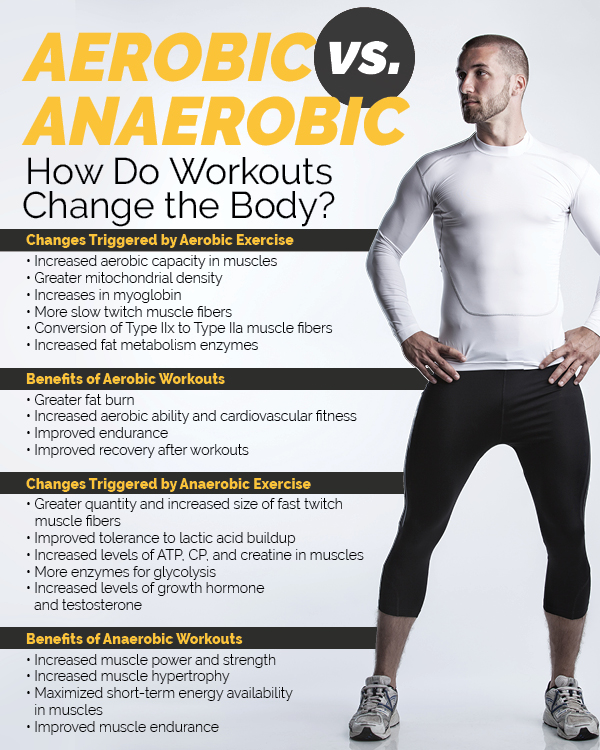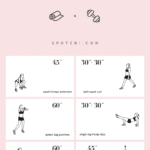To improve aerobic fitness, engage in regular cardiovascular exercises like running, swimming, or cycling. Maintain a consistent workout routine to see results.
Aerobic fitness is crucial for overall health and well-being. It enhances cardiovascular health, boosts energy levels, and aids in weight management. Regular aerobic exercises like running, swimming, and cycling increase your heart rate and improve lung capacity. These activities not only strengthen the heart but also enhance blood circulation.
Incorporate at least 150 minutes of moderate aerobic activity or 75 minutes of vigorous activity weekly. Consistency is key; sticking to a routine ensures better endurance and stamina. Always warm up before exercises and cool down afterward to prevent injuries. Stay hydrated and maintain a balanced diet to support your fitness goals.
Credit: orthoinfo.aaos.org
Introduction To Aerobic Fitness
Aerobic fitness means strong heart and lungs. It helps your body use oxygen better. Aerobic exercises include running, swimming, and cycling. These activities improve your stamina and overall health.
Benefits Of Aerobic Fitness
- Heart Health: Regular aerobic exercise strengthens your heart.
- Weight Management: Helps you burn calories and maintain a healthy weight.
- Mood Improvement: Releases endorphins, making you feel happier.
- Better Sleep: Regular activity can improve your sleep patterns.
- Increased Stamina: Boosts your endurance, making daily tasks easier.
Key Principles
- Consistency: Aim for regular workouts. Even short sessions help.
- Intensity: Gradually increase the intensity of your exercises.
- Variety: Mix different activities to keep things interesting.
- Hydration: Drink water before, during, and after workouts.
- Rest: Allow your body to rest and recover after workouts.

Credit: www.issaonline.com
Setting Realistic Goals
Setting realistic goals is key to improving your aerobic fitness. Goals help you stay focused and motivated. They give you a clear path to follow.
Short-term Goals
Short-term goals are goals you can achieve quickly. They help you see progress and stay motivated. Here are some examples:
- Walk for 30 minutes three times a week.
- Jog for 15 minutes twice a week.
- Join a local fitness class.
Track your progress using a fitness app. Apps show your progress and keep you motivated.
Long-term Goals
Long-term goals take more time to achieve. They push you to go further. Here are some examples:
- Run a 5k race in six months.
- Cycle 20 miles without stopping.
- Swim 30 laps in a pool.
Break down long-term goals into smaller steps. Smaller steps make big goals feel easier. Celebrate each small win.
| Goal Type | Example | Time Frame |
|---|---|---|
| Short-term | Walk 30 minutes | 1 week |
| Long-term | Run a 5k race | 6 months |
Setting realistic goals helps you improve your aerobic fitness step by step. Focus on both short-term and long-term goals. Stay committed and watch your fitness grow.
Effective Aerobic Exercises
Improving aerobic fitness can boost heart health and stamina. Effective aerobic exercises help in achieving these goals. Below, we explore some of the best aerobic exercises for improving fitness.
Running And Jogging
Running and jogging are excellent for improving aerobic fitness. They strengthen the heart and lungs. Running burns a lot of calories and helps in weight loss. Jogging is easier on the joints than running.
To start, aim for short distances. Gradually increase your distance and speed. A good pair of running shoes is essential to prevent injuries. Run on various terrains to keep things interesting.
Cycling And Swimming
Cycling and swimming are effective low-impact aerobic exercises. They are great for people with joint issues. Both exercises improve heart health and endurance.
Cycling can be done outdoors or on a stationary bike. It is great for leg strength and balance. Swimming works the entire body and is very gentle on the joints.
Below is a table showing the benefits of each exercise:
| Exercise | Benefits |
|---|---|
| Running | Improves heart health, burns calories |
| Jogging | Good for beginners, less impact on joints |
| Cycling | Low-impact, strengthens legs |
| Swimming | Full-body workout, gentle on joints |
Incorporate these exercises into your routine to improve aerobic fitness. Set achievable goals and track your progress. Stay consistent and enjoy the journey to better health.
Structuring Your Workout Routine
Structuring your workout routine is crucial for improving aerobic fitness. A well-organized routine ensures balanced progress and avoids injuries. Let’s dive into the essential elements of structuring your workout effectively.
Frequency And Duration
Consistency is key to aerobic fitness. Aim for regular workouts to see progress. Here’s a simple guide:
- Beginner: 3-4 days per week, 20-30 minutes per session
- Intermediate: 4-5 days per week, 30-45 minutes per session
- Advanced: 5-6 days per week, 45-60 minutes per session
Rest days are important too. They help your body recover and grow stronger. Ensure you have at least one rest day each week.
Intensity Levels
Varying intensity levels boosts your aerobic capacity. Use a mix of low, moderate, and high-intensity workouts:
| Intensity Level | Description | Examples |
|---|---|---|
| Low | Easy pace, can talk easily | Walking, light jogging |
| Moderate | Comfortable, slight breathlessness | Brisk walking, steady running |
| High | Hard, difficult to talk | Sprinting, high-intensity intervals |
Incorporate all intensity levels into your routine. This approach keeps workouts engaging and effective. Try this weekly structure:
- Day 1: Low intensity
- Day 2: Moderate intensity
- Day 3: Rest
- Day 4: High intensity
- Day 5: Moderate intensity
- Day 6: Low intensity
- Day 7: Rest
This balanced approach ensures comprehensive aerobic fitness improvement.
Incorporating Interval Training
Interval training is a powerful method to improve aerobic fitness. It involves alternating between high and low-intensity exercises. This technique boosts cardiovascular health, burns calories, and enhances endurance. Let’s explore two popular types of interval training: High-Intensity Interval Training (HIIT) and Low-Intensity Steady State (LISS).
High-intensity Interval Training
High-Intensity Interval Training (HIIT) is a popular workout method. HIIT involves short bursts of intense activity followed by rest. These workouts are quick but very effective. They can be done with various exercises like running, cycling, or bodyweight movements.
- Short Duration: Sessions usually last 20-30 minutes.
- Versatile: Can be done anywhere, anytime.
- Efficient: Burns a lot of calories in a short time.
Here is an example of a simple HIIT workout:
| Exercise | Duration | Rest |
|---|---|---|
| Running | 30 seconds | 1 minute |
| Jumping Jacks | 30 seconds | 1 minute |
| Burpees | 30 seconds | 1 minute |
Repeat this cycle 4-5 times for a complete workout. HIIT improves aerobic fitness quickly and effectively.
Low-intensity Steady State
Low-Intensity Steady State (LISS) is another form of interval training. LISS involves longer periods of low-intensity exercise. This method is less intense but still beneficial.
- Sustained Effort: Typically 30-60 minutes of continuous activity.
- Low Impact: Easier on the joints and muscles.
- Accessibility: Great for beginners or those with injuries.
Examples of LISS activities include:
- Walking
- Light jogging
- Swimming
- Cycling
LISS helps build aerobic endurance without overexertion. It is perfect for recovery days or low-energy periods. Combining HIIT and LISS can create a balanced fitness routine. This mix ensures variety and sustained progress in aerobic fitness.
Monitoring Your Progress
Keeping track of your aerobic fitness is crucial. It helps you see improvements and stay motivated. Let’s explore how you can monitor your progress effectively.
Tracking Tools
Using the right tools can make tracking easier and more accurate.
- Fitness Apps: Apps like Strava and MyFitnessPal can log your workouts and stats.
- Wearable Devices: Devices like Fitbits and Apple Watches track your heart rate and steps.
- Heart Rate Monitors: These provide real-time data on your heart rate during exercise.
These tools help you see daily and weekly trends. This can motivate you to keep pushing forward.
Adjusting Your Plan
Regularly reviewing your progress is essential. It ensures you’re on the right track.
- Set Clear Goals: Define what you want to achieve each week.
- Review Weekly Data: Look at your stats every week to see improvements.
- Modify Workouts: Adjust your workouts based on your progress. Increase intensity if needed.
For instance, if your heart rate is too low, increase your workout intensity. If you’re feeling fatigued, consider more rest days.
Here’s a simple table to help you plan and adjust:
| Week | Goal | Progress | Adjustments |
|---|---|---|---|
| 1 | Run 3 miles | Completed | Increase to 4 miles |
| 2 | Run 4 miles | Struggled | Maintain 4 miles, add rest day |
By adjusting your plan, you avoid plateaus and keep improving.
Nutrition For Aerobic Fitness
Proper nutrition is key for improving aerobic fitness. Eating the right foods fuels your body and boosts your performance. It also aids in recovery. The right balance of nutrients can make a big difference.
Pre-workout Meals
A good pre-workout meal sets the stage for a great session. Eat 2-3 hours before your workout. This meal should be rich in carbohydrates and have some protein.
- Whole grain bread with peanut butter
- Oatmeal with fruits
- Yogurt with granola
Try to avoid heavy, fatty foods. They can slow you down. Hydrate well before starting your exercise.
Post-workout Recovery
Recovery starts right after you finish your workout. Your body needs nutrients to repair and grow. Eat within 30 minutes of finishing your exercise. This period is often called the “golden window.”
| Nutrient | Purpose | Sources |
|---|---|---|
| Protein | Repair and build muscles | Chicken, fish, tofu |
| Carbohydrates | Refuel energy stores | Rice, pasta, sweet potatoes |
| Fats | Support cell function | Avocados, nuts, seeds |
Hydration is also important. Drink water or an electrolyte drink. This helps you recover faster and feel better.
Preventing Injury
Improving aerobic fitness is important for your health. But preventing injury is even more crucial. Injuries can hinder your progress and cause long-term damage. Follow these tips to stay safe and healthy.
Proper Warm-up And Cool-down
A proper warm-up is essential before starting any exercise. It prepares your body for the workout. Begin with light activities like walking or gentle jogging. This increases blood flow to your muscles.
- Warm up for at least 5-10 minutes.
- Include dynamic stretches like leg swings and arm circles.
Cooling down is equally important. It helps your body recover. Slow down gradually after exercise. Do some static stretches to relax your muscles.
- Cool down for 5-10 minutes.
- Stretch all major muscle groups.
Listening To Your Body
Your body gives signals when something is wrong. Pay attention to these signals to prevent injury. Stop exercising if you feel pain. Don’t ignore aches and discomfort.
- Take rest days to allow your body to heal.
- Use the RICE method: Rest, Ice, Compression, Elevation for minor injuries.
Gradually increase the intensity of your workouts. Avoid sudden changes that can stress your body. Listen to your body’s needs and adjust accordingly.
Staying Motivated
Staying motivated is key to improving aerobic fitness. Motivation helps you stay on track and achieve your goals. Without motivation, it’s easy to give up. Below are some tips to keep you motivated.
Finding A Workout Buddy
Having a workout buddy can make exercise more enjoyable. A friend can push you to do better. You can keep each other accountable.
Here are some benefits of a workout buddy:
- Consistency: You’re less likely to skip workouts.
- Support: You can motivate each other.
- Fun: Workouts are more enjoyable with a friend.
Setting New Challenges
Setting new challenges keeps things exciting. Challenges push you to achieve more. They help you track your progress.
Consider these types of challenges:
- Distance Goals: Aim to run or bike a certain distance.
- Time Goals: Try to complete a workout in a set time.
- Skill Goals: Learn a new exercise or technique.
Tracking your challenges helps you see improvements. Use a journal or an app to log your progress.

Credit: veloforte.com
Frequently Asked Questions
How Is Aerobic Fitness Improved?
Engage in regular cardio exercises like running, cycling, or swimming. Increase intensity and duration gradually. Maintain consistency for best results.
How To Build Aerobic Fitness Fast?
To build aerobic fitness fast, engage in high-intensity interval training (HIIT). Incorporate regular running, swimming, or cycling sessions. Consistency is key. Maintain a balanced diet and stay hydrated. Get adequate rest and recovery.
How Long Does It Take To Improve Aerobic Fitness?
Improving aerobic fitness typically takes 4-6 weeks with consistent exercise. Aim for 150 minutes of moderate activity weekly.
How Do You Increase Your Aerobic Capacity?
Increase aerobic capacity by engaging in regular cardiovascular exercises like running, cycling, or swimming. Gradually increase workout intensity and duration. Include interval training and maintain a consistent routine. Ensure proper nutrition and hydration. Rest and recovery are crucial for progress.
Conclusion
Boosting aerobic fitness is achievable with commitment and the right strategies. Incorporate various exercises to keep it engaging. Stay consistent, listen to your body, and gradually increase intensity. With dedication, you’ll see improvements in endurance, energy levels, and overall health.
Start today and enjoy the journey to better fitness.





Comments are closed.